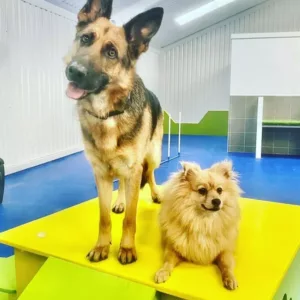Every dog is different, especially when it comes to adjusting to new surroundings. From a puppy, to a rescue, to a pre-trained dog: we have compiled all the tips on how to welcome in your furry new addition and make them feel right at home.
Comforting Your Dog In A New Home
Be Patient
Before you begin, it is important to remember to be patient – it is perfectly natural for your dog to be anxious or uncomfortable in a new environment. Each dog gets used to things at their own pace; it is important to watch for signs and take it as slowly as they need.
Prepare Your House Beforehand
We would recommend checking in advance to make sure your house is prepared for your new arrival. This is because if you make multiple stops on your way home, such as at the pet shop, for example, this may distress your dog.
Preparation includes making sure you have all the necessary items, such as food and water bowls, the food and water itself, leads and collars etc.
Take Care When Introducing Existing Animals
A second dog can help keep your dog entertained when you are out of the house all day, however, this could lead to high-spirited behaviour and barking. Therefore, it is vital to introduce your new dog in the right way to avoid territorial aggression and help them build a bond.
Things to consider when starting a multi-pet household include:
Choosing The Right Dog
You should take care when choosing your second dog, matching their temperament and energy levels to your current dog. We offer a range of temperaments and breeds to choose from to help you have the best chance at settling them into your existing family.
Introducing Them On Neutral Ground
We recommend having the initial meeting on neutral ground, whether this is at our training facility or going on a walk together before you go inside the house. This will avoid your existing dog from feeling like their territory is being invaded.
Additionally, when you get back, let your existing dog off the lead while you walk the new dog on a lead around your home.
Creating Safe Spaces
Entering a new home can be overwhelming for your dog; therefore, it is important to give them plenty of space to settle in. You should not try to force interaction, especially if they are shy.
Whether they are the only pet in the house or not, it may also be helpful to bring any familiar objects from your new dog’s previous home to help them feel comfortable in a new environment which has lots of unfamiliar smells.
When You Already Have A Dog
Introducing the dogs as slowly and gradually as possible is the best way to make sure they become long-term friends.
Before you bring home your new dog, you should gather all the toys, blankets, and other items belonging to your existing dog and put them in one place. This will help minimise any potential conflict. You should have a separate area for your new dog’s items to start with – they may share eventually, but for now, it is best to keep things simple and separate.
If possible, you should also put up baby gates or similar barriers to create distinct areas in your home. This allows you to go out and leave the two of them alone, without worrying about confrontation. Additionally, you should also feed them in separate areas, to begin with, to avoid competition for food. A bed or crate in a quiet room where your dog can rest is especially important in a busy house.
Introducing Dogs To Other Animals
In the case of animals such as cats, it is not recommended to introduce them without a barrier between them for their comfort. You should make sure your cat has somewhere to hide if they feel threatened or fearful. In the context of smaller animals like guinea pigs, dogs will likely view them as prey, so it is important to keep your dog away from them.
Don’t Leave Them Alone For Too Long
Before leaving a new dog for prolonged periods of time, we would recommend starting off with smaller intervals of around 5–10 minutes, gradually increasing this as they become more comfortable. You should make sure to leave them with enrichment items to keep them entertained and minimise the potential for disruptive behaviour.
House Training & Routines
If your new furry friend is a rescue or a puppy, it is more than likely that they will not be house-trained. For this reason, it may be helpful to have puppy pads indoors just in case of any accidents in the initial adjustment period.
Establishing a routine and not leaving them for too long will help avoid the development of separation anxiety and resultant behavioural issues.
How To Settle A Dog Into A New Home At Night
It is recommended that you do not shut them in their crate at night, to begin with. It can be helpful to start off sleeping in the same room as them and then gradually move away. If they tend to cry when you are further away, you can go back to sleeping in the same room and make the speed at which you move the bed away even slower.
You could also make sure they have plenty of enrichment activities that are safe for unsupervised use, such as toys or puzzles.
If you follow all these steps, and they still cry when you are not close to them, then this may be indicative of separation anxiety. Our dog training classes can help with this.
Settling In A New Puppy
Settling in a new puppy is a lot different from settling in older dogs and rescues. They are often full of more energy and require a great deal of patience and monitoring to keep them out of trouble! Alongside the advice above, it is important to pay attention to the following tips:
Set Ground Rules
In advance of your new arrival, it is important to set ground rules based on how you want them to interact with spaces in your home. For example, will you let them sleep on the bed, or are there certain rooms you do not want them to go in?
Set Up Their Personal Area
Before they come home, you should consider where you want your puppy’s food, water, and bed to be. These should be somewhere that they can easily get to. You should make sure to show them where they can go to the toilet, placing puppy pads around the room.
It is important not to give them access to too much of your house in one go, as it can be overwhelming.
Avoid Visitors At First
Similarly, it is recommended that you avoid visitors in the first few days to give your puppy a chance to adjust to the new surroundings. This also extends to getting used to the people who will commonly be in the house before introducing new ones.
Puppy Proof Your House In Advance
Puppies can be incredibly curious, so it is essential that you hide anything that you do not want them to destroy, as well as foods and plants that may be potentially poisonous to them.
It can also be helpful to get baby gates to lower the risk of your puppy entering rooms they are not allowed into, or using stairs before they are ready.
The First Night With A New Puppy
The first night with a new puppy can be the hardest one. This is because they will likely have become used to sleeping with their mum and siblings, and will have to adjust to them not being there, on top of unfamiliar surroundings. Crying and barking is completely normal at first as they get used to their new home.
Ultimately, every puppy is different. However, these tips can help make sure your puppy is as comfortable as possible:
- Introduce a set bedtime and sleeping location from the start to establish a routine.
- Use a blanket or other item that smells of their mum from their breeder if you have it.
- Remove distractions where possible, by shutting curtains and keeping your nighttime activities quiet and relaxed.
- Start with their bed in your bedroom, before gradually moving it away.
- Make sure to comfort them when they cry or bark during the night, as leaving them alone and ignoring them can make them feel isolated or frightened.
Living With A Fully Trained Dog – Integrating Them Into Your Family
Fully trained dogs are easier to integrate into a new home because they have been taught how to behave and what is expected of them.
You’ll find that they quickly adapt to their new surroundings and provide companionship and company for your existing dog. You may even find it easier to train your current dog when they see their playmate responding so well to commands.
Easing Them Into Their New Home
It is important to note that they will be attached to the trainers at the facility; this means that they will need around 4–6 weeks to get used to their new environment and owner.
Ultimately, taking your time, planning carefully and paying attention in the first few days will make all the difference when it comes to integrating a new dog into your home. To ease their transition in these first few weeks, we recommend that you:
- Give them lots of treats
- Be caring, and patient, and focus on making sure they are happy and comfortable
- Avoid introducing commands during this adjustment period to help them feel at ease and build trust with you
Before you know it, you will have two best friends for life and a more peaceful and balanced home for everyone.
Get in touch with us for advice; if you are looking to get a new addition to your family, you can view our selection of trained and family protection dogs here.
Settling In A New Dog FAQs
Do Dogs Get Stressed In A New House?
Moving house can disrupt the routine of even your existing dog; they are also affected by your emotions. This means that if you are stressed, which you likely are when you move house, it is safe to say that they will be too. Therefore, it is vital to keep as much normality as possible when it comes to your dog’s routine throughout the moving process.
It is also recommended that you unpack your dog’s belongings first so that they can enter the new home and smell familiar items. You should also let them explore the new space at their own pace, with you at their side for reassurance. They may go to the toilet in unusual locations while they adjust, so it is important to be patient with even the most experienced of dogs.
How Long Will It Take My Dog To Get Used to a New Home?
You can expect it to take around four to six weeks for your dog to get used to an unfamiliar environment. Generally, this is the amount of time it takes for them to establish a bond. However, it is important to note that each dog is different and there is no hard and fast rule for settling in every dog.
For example, they are more likely to be stressed if they are a rescue and have survived a traumatic experience, whereas a pre-trained dog is not likely to need the same level of reassurance.
How Long Does It Take A Rescue Dog to Settle?
When it comes to rescue dogs, it is likely that they will have been through a traumatic event; as a result, they may be a little more vulnerable than other dogs. It can take a few weeks for them to even begin to open up to you.
How Can I Help A Rescue Dog Settle In?
Like with puppies and trained adult dogs, you should make sure you buy all the essentials beforehand, as well as dog-safe cleaning products. You should also dog-proof your house and plan out where your dog will sleep etc, as well as making sure they have their own quiet safe space away from the busier areas of the house.
You should follow the guidance above on introducing them to your existing animals with extra care and attention. It is also helpful to consider the fact that they may hide from you at first; it is best to avoid visitors initially.
Also, you should not force interaction with them and let them have alone time to relax at their own pace.
If you have recently rehomed a rescue, you can get in touch with us for advice on training, including socialisation and house training, as well as behavioural support, whatever stage your dog is at on its journey.




